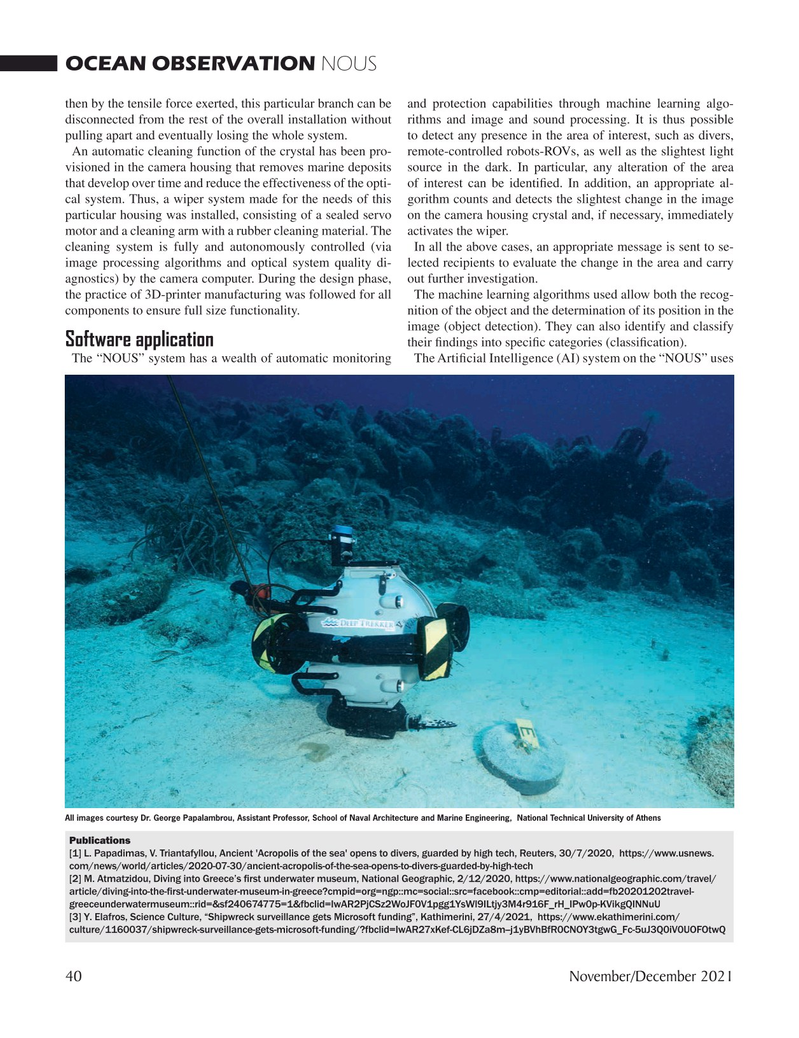
Page 40: of Marine Technology Magazine (November 2021)
Ocean Observation: Gliders, Buoys & Sub-Surface Networks
Read this page in Pdf, Flash or Html5 edition of November 2021 Marine Technology Magazine
OCEAN OBSERVATION NOUS then by the tensile force exerted, this particular branch can be and protection capabilities through machine learning algo- disconnected from the rest of the overall installation without rithms and image and sound processing. It is thus possible pulling apart and eventually losing the whole system. to detect any presence in the area of interest, such as divers,
An automatic cleaning function of the crystal has been pro- remote-controlled robots-ROVs, as well as the slightest light visioned in the camera housing that removes marine deposits source in the dark. In particular, any alteration of the area that develop over time and reduce the effectiveness of the opti- of interest can be identi? ed. In addition, an appropriate al- cal system. Thus, a wiper system made for the needs of this gorithm counts and detects the slightest change in the image particular housing was installed, consisting of a sealed servo on the camera housing crystal and, if necessary, immediately motor and a cleaning arm with a rubber cleaning material. The activates the wiper. cleaning system is fully and autonomously controlled (via In all the above cases, an appropriate message is sent to se- image processing algorithms and optical system quality di- lected recipients to evaluate the change in the area and carry agnostics) by the camera computer. During the design phase, out further investigation. the practice of 3D-printer manufacturing was followed for all The machine learning algorithms used allow both the recog- components to ensure full size functionality. nition of the object and the determination of its position in the image (object detection). They can also identify and classify
Software application their ? ndings into speci? c categories (classi? cation).
The “NOUS” system has a wealth of automatic monitoring The Arti? cial Intelligence (AI) system on the “NOUS” uses
All images courtesy Dr. George Papalambrou, Assistant Professor, School of Naval Architecture and Marine Engineering, National Technical University of Athens
Publications [1] L. Papadimas, V. Triantafyllou, Ancient 'Acropolis of the sea' opens to divers, guarded by high tech, Reuters, 30/7/2020, https://www.usnews.
com/news/world/articles/2020-07-30/ancient-acropolis-of-the-sea-opens-to-divers-guarded-by-high-tech [2] M. Atmatzidou, Diving into Greece’s ? rst underwater museum, National Geographic, 2/12/2020, https://www.nationalgeographic.com/travel/ article/diving-into-the-? rst-underwater-museum-in-greece?cmpid=org=ngp::mc=social::src=facebook::cmp=editorial::add=fb20201202travel- greeceunderwatermuseum::rid=&sf240674775=1&fbclid=IwAR2PjCSz2WoJF0V1pgg1YsWl9ILtjy3M4r916F_rH_IPw0p-KVikgQINNuU [3] ?. Elafros, Science Culture, “Shipwreck surveillance gets Microsoft funding”, Kathimerini, 27/4/2021, https://www.ekathimerini.com/ culture/1160037/shipwreck-surveillance-gets-microsoft-funding/?fbclid=IwAR27xKef-CL6jDZa8m--j1yBVhBfR0CNOY3tgwG_Fc-5uJ3Q0iV0UOFOtwQ 40 November/December 2021
MTR #8 (34-49).indd 40 11/22/2021 1:02:40 PM

 39
39

 41
41
